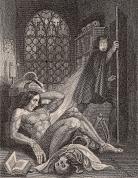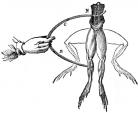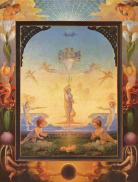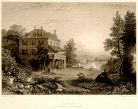Dang's Timeline for Frankenstein
Created by Dang Hai on Sun, 12/05/2021 - 00:25
Part of Group:
Mary Shelley wrote her Frankenstein in the 18th century and was inspired by many of the great changes taking place around the world such as politics, economics and many aspects of science. Especially the development of the period of romanticism literature. My timeline will show what influenced Mary Shelley and her Frankenstein or the Modern Prometheus.
Timeline
Chronological table
| Date | Event | Created by | Associated Places | |
|---|---|---|---|---|
| 1765 |
The GothicThe Gothic title first appeared in literature in 1765 through the story "The Castle of Otranto: A Gothic Story" by Horace Walpole and developed during the period of Romanticism. The Gothic is a literary genre that uses dark images, horror elements and a mysterious atmosphere to vivifying the imagination and arouse feelings of fear in the reader, but still exists the presence of romance, so that in Gothic works it is often possible to find Romanticism. Referring to The Gothic, readers will often find supernatural elements, uncanny, strange places like ancient castles or monasteries. In addition, shifts in power are easily seen in Gothic novels between individuals who maintain power and others who are vulnerable. The possession of power will also be associated with elements of sexuality or sexual power, often in the form of coercion and violence. Mary Shelley's Frankenstein horror story is a peaked of Gothic literature in Romanticism. The combination of Romanticism and Gothic made Frankenstein unique with its mysterious and supernatural elements at a time when Romanticism was widespread in Europe. MLA Works Cited Entry “Literary Terms: Gothic, Grotesque, and the Uncanny.” The Masters Review, 16 Oct. 2015, https://mastersreview.com/literary-terms-gothic-grotesque-and-the-uncanny/. Kennedy, Patrick. “What Is Gothic Literature?” ThoughtCo, ThoughtCo, 23 Jan. 2020, https://www.thoughtco.com/gothic-literature-2207825. |
Dang Hai | ||
| circa. 1780 |
GalvanismIn the late 18th century, an Italian physician, physicist, biologist and philosopher named Luigi Galvani discovered Galvanism, it is the application of electric current to living or non-living tissue of an organic matter. He suggested that the electricity was generated from the animal's muscular and nervous systems by observing the twitching responses of a pair of dead frog legs when exposed to a metal or magnetic alloy and electrically connected with an electrolyte. From this it is hypothesized that "galvanism" can revive dead tissue and possibly restore life. Electricity was a new discovery in the late 18th century, so it is understandable why Luigi Galvani made a wrong assumption, but it was appropriate for the circumstances at that time. The same goes for thinking that you can use electricity to bring the dead back to life. It was this supernatural element that attracted Mary Shelly, causing her to include Galvanism in her story, as a huge discovery for Victor Frankenstein, which he learned and applied to his project that later changed his whole life. MLA Works Cited Entry Magazine, Smithsonian. “How Twitching Frog Legs Helped Inspire 'Frankenstein'.” Smithsonian.com, Smithsonian Institution, 4 Dec. 2015, https://www.smithsonianmag.com/smart-news/how-twitching-frog-legs-helped.... “Galvanism.” Wikipedia, Wikimedia Foundation, 3 Dec. 2021, https://en.wikipedia.org/wiki/Galvanism. “Not Even Past: Social Vulnerability and the Legacy of Redlining.” History Engine 3.0, https://historyengine.richmond.edu/episodes/view/4808. |
Dang Hai | ||
| 1800 |
RomanticismRomanticism began in the late 18th century, arguably as an important revolutionary movement as a response to the French Industrial Revolution and the Enlightenment. This led Romanticism to be seen as the Revolution form of poetry as a call for reform and revolutionary. Romantic writers and poets had the theme of changing the view of nature, instead of focusing on the rigid development of industry. They believe that the beauty of nature is also the beauty of the human soul. They want to be in harmony with nature, looking for the grandeur that nature has. Besides the tranquil beauty of nature, there are also unpredictable and uncontrollable factors, such as terrible storms, thunder, volcanic eruptions, etc. Feelings of awe at those phenomena help writers and poets to sense and feel the supernatural things, the Sublimes, thereby stimulating their adventurousness, curiosity and imagination. In Mary Shelley's Frankenstein, many elements of Romanticism can be found. From the imaginatively inspired idea of being able to bring a dead creature back to life, to the creature's first feelings and senses about nature and its desire for equality it should have been received. MLA Works Cited Entry Metmuseum.org, https://www.metmuseum.org/toah/hd/roma/hd_roma.htm. “Romanticism.” Wikipedia, Wikimedia Foundation, 5 Dec. 2021, https://en.wikipedia.org/wiki/Romanticism. |
Dang Hai | ||
| Summer 1816 |
The Villa DiodatiVilla Diodati is a mansion near Lake Geneva in Switzerland, rented in summer of 1816 by an English poet George Gordon Byron, known as Lord Byron, and his friend John William Polidori, an English writer and physician. Both are known to be associated with the movement of Romanticism. In that same fateful summer, Mary Shelley and her companion Percy Bysshe Shelley were trapped in their rented house because of extremely erratic weather with prolonged heavy rains accompanied by thunder. This inspired both of them to read horror stories, only to be advised by their neighbor Lord Byron to go to Villa Diodati and start a horror story writing contest later. Under the flickering candlelight and the terrible storm outside the window, Mary Shelley composed what is considered a landmark of Gothic horror: Frankenstein. MLA Work Cited “Villa Diodati.” Wikipedia, Wikimedia Foundation, 6 Aug. 2021, https://en.wikipedia.org/wiki/Villa_Diodati. Buzwell, Greg. British Library, https://www.bl.uk/romantics-and-victorians/articles/mary-shelley-franken.... |
Dang Hai | ||
| 16 Aug 1819 |
Peterloo MassacreThe Peterloo Massacre of August 16, 1819 was a famous political demonstration of the working class and the poor. As a response to the French Revolution and the Industrial Revolution, 60,000 people gathered at a meeting in St Peter's Field led by the radical leader Henry Hunt. The purpose of the meeting was to rally together to protest against high rents and prices, as well as public discontent and political reform coming from parliament. However, the protest was quelled by an army sweep, a completely unequal battle between the army's professional weapons and the tools of workers and bare hands. The brutal massacre left hundreds injured and 15 killed. Even so, the voices of the people demanding liberty and equality led to large numbers of people to stand up and uniting for a better society. This had became a great inspiration for Romanticism poets and writers of the late 18th century, as Percy Bysshe Shelley with the The Mask of Anarchy, England in 1819, etc. In Frankenstein, the "creature" was born in a time of technological and industrial development, like the present time. There are connections between the "creature" and the working class at this time when both are abandoned and both are in search of their own liberty and equality. Through Frankenstein, it can be seen that Mary Shelley's sympathy for the unemployed has been left behind in this age of economic and industrial crisis. MLA Works Cited Entry Barham, Marc. “Frankenstein: The Shelley's and the Peterloo Massacre.” Medium, Medium, 16 Aug. 2021, https://marcbarham.medium.com/frankenstein-the-shelleys-and-the-peterloo.... “Peterloo Massacre.” Encyclopædia Britannica, Encyclopædia Britannica, Inc., https://www.britannica.com/event/Peterloo-Massacre. |
Dang Hai |





